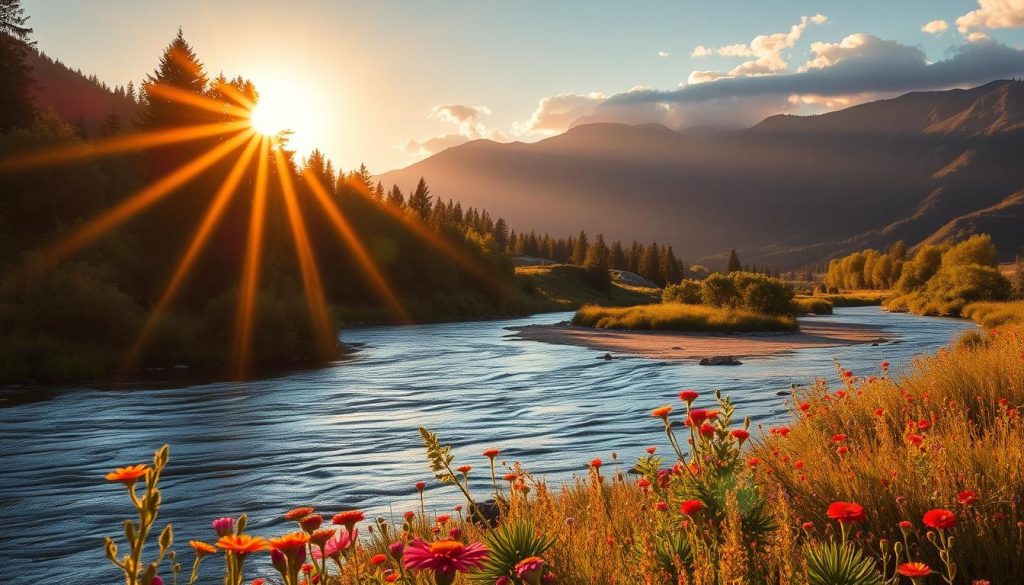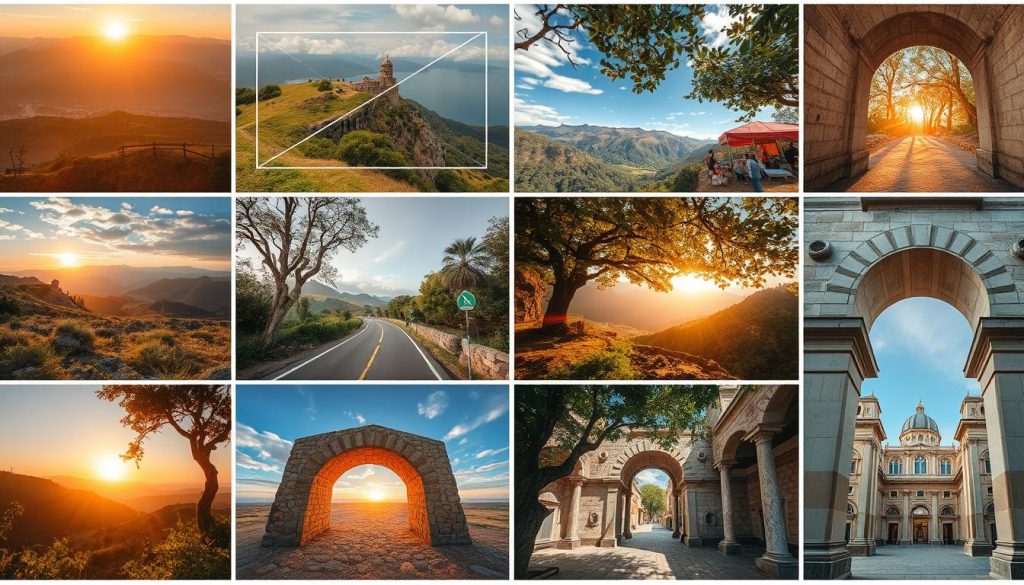Travel photography is like a time machine, capturing memories from your journey. It lets you relive those moments for years to come. Learning to capture the unique culture, history, and people of a place can share its spirit with others. Planning your photos beforehand can greatly improve your results, making sure you get the best shots when you arrive1.
About 10-15% of travel photos are just okay, and only 1-5% are really good1. Mastering travel photography can make you stand out. It helps you capture the essence of your trips, whether it’s landscapes, portraits, or night scenes. Learning the right techniques can make all the difference.
Key Takeaways
- Travel photography is a powerful way to preserve memories and share the spirit of a destination with others.
- Proper planning and preparation can significantly improve the quality of your travel photos.
- Mastering techniques like natural light management, composition, and ethical considerations can help you create visually captivating images.
- Approximately 85% of travel photographs end up being of poor quality, highlighting the importance of learning travel photography tips1.
- Different weather conditions and lighting directions present both challenges and creative opportunities for travel photographers1.
The Importance of Planning for Travel Photography
Getting ready for your travel photography trip is key to getting amazing shots. By doing your homework on locations, picking what shots you want, and finding the best spots, you can make the most of your time. This way, you’ll leave with a collection of photos that really capture the moment2.
Researching Locations and Perspectives
Begin by checking out Pinterest, Instagram, and Google Images for travel photos that inspire you. Save these images in a folder for later. Look up what other photographers have to say on Google to learn the best places for taking pictures at certain spots2.
Use digital tools like Google Earth and Google Maps to help plan even better. Google Earth lets you see photos marked with GPS by other people, which helps you find great spots for your photos. Google Maps’ street view shows you what a place looks like from the ground, helping you plan your shots2.
Identifying Desired Shots and Vantage Points
After you know what you want to capture and where, use your research to find the best spots. Knowing where to stand before you get there means you won’t waste time and you’ll get the shots you had in mind2.
Putting in the effort to plan will help you capture the true spirit of your destinations. You’ll end up with a set of photos that tell a story and look great together2.
Using Online Resources for Location Scouting
As a travel photographer, you can use online tools like Google Earth and Google Street View to find great spots before you go3. Just search for your destination in Google Earth and turn on user photos to see where others have taken pictures3. This helps you know where to go to get the shots you want. Then, Google Street View lets you see the area from the ground, so you can walk through it and check out different views4.
Leveraging Google Earth and Street View
Google Earth is a must-have for photographers, letting you explore places from home. By searching for your spot and turning on the “Photos” layer, you can see where others have taken pictures3. This gives you a jumpstart on planning your shots. Google Street View then helps you walk through the area, find the best spots, and spot any problems that might get in your way4.
Tools like Google Maps and apps like OnXHunt are also great for finding places to take pictures4. Many photographers use apps like PhotoPills to plan shots based on the sun’s position, making sure they get the perfect light3.
Joining online photography groups can also help you find great places and get tips from other photographers3. Sharing your own tips and experiences can help everyone find the best spots to capture the beauty of a place3.
Remember, getting ready is key to great travel photography. Using online tools and scouting ahead lets you make the most of your time, capturing amazing shots that show off your destination’s beauty43.
Mastering Natural Light for Travel Photography
Learning to work with natural light is key for travel photographers. It changes a lot, from the warm glow of the golden hour to the cool tones of the blue hour. Knowing how to use these lights can make your photos stand out5.
Golden Hour and Blue Hour Photography
The golden hour happens right after sunrise or before sunset. It gives a beautiful, soft light perfect for portraits and landscapes6. This light makes shadows soft and adds a golden tone to your photos6.
The blue hour comes before sunrise or after sunset. It gives a cool, dreamy light ideal for night scenes and city views6.
Working with Midday and Inclement Weather Light
Midday sun can be tough but useful for filling shadows and highlighting details6. Overcast days offer a soft, even light and reflections that add depth6. Adjusting your camera settings lets you take great photos in any light7.
To master natural light, be patient, flexible, and pay attention to how you frame your shots6. Try using reflectors or leading lines to improve your travel photos7.
| Natural Light Type | Characteristics | Best for |
|---|---|---|
| Golden Hour | Warm, soft, long shadows | Portraits, landscapes, nature |
| Blue Hour | Cool, ethereal, low-light | Nightscapes, cityscapes |
| Midday Sun | Harsh, high-contrast | Architectural features, calm waters |
| Overcast/Rainy | Diffused, soft, reflective | Portraits, moody scenes |

“There is no such thing as bad light, only different qualities of light.” – Unknown5
By using the unique qualities of natural light and adjusting your approach, you can take amazing travel photos that capture the spirit of your destinations6.
Composition Techniques for travel photography tips
To improve your travel photos, try out various photography composition methods. Start by using the rule of thirds. Place important parts of your scene along the grid lines for a balanced look8.
Add depth to your photos with elements in the foreground, midground, and background. Use leading lines like paths or rivers to guide the viewer’s eye8.
- Experiment with different angles, like getting low or high up, for a fresh view8.
- Use natural elements like windows or trees to frame your subject, adding interest and a sense of framing8.
“Composition is key to great travel photos and greatly affects their quality.”8
This article shares 12 tips for travel photography composition, covering landscapes, cityscapes, and more8.

Using symmetry in travel photos adds balance and harmony8. Leading lines guide the viewer’s eye and add movement to your shots8.
Get close to your subject to reveal details or step back for a broader view. This approach makes your photos more engaging8. Shooting from above offers a new view of familiar scenes8.
The rule of thirds helps place elements one-third into the frame for balanced images8. Minimalism in travel photography uses empty space to tell a story8.
Centering your subject in the frame makes for a striking image that focuses on the main theme8. Layering involves placing subjects at different distances for depth and harmony8.
Conclusion
Learning the art of travel photography is a journey that never ends. It’s filled with rewards. By following the best travel photography tips and trying new things, you can capture the true spirit of places. This way, your photos will touch the hearts of your viewers9.
It’s important to be open and flexible when taking travel photos. Don’t be afraid to face new challenges. Sometimes, the best creative and compelling photos come from trying something new10.
As you get better at improving your travel photos, use online tools to find great locations and learn about light and composition. This will help you avoid common clichés and capture the real essence of where you go109.
FAQ
What is the importance of travel photography?
Travel photography captures memories from your journey. It lets you relive those moments for years. By capturing the culture, history, and people of a place, you share its spirit with others. This gives them a peek into what it’s like to visit.
How can I plan and prepare for better travel photos?
Start by researching your destinations and identifying key shots. Look at Pinterest, Instagram, and Google Images for inspiration. Save these images for later.
Use Google Earth and Street View to find the best spots for your camera. This helps you plan your shots before you go.
How can Google Earth and Google Street View help with travel photography?
Google Earth and Street View are great for scouting locations. They let you see where other photographers have taken pictures. This helps you find the best spots for your shots.
Google Street View also gives you a street-level view of your destination. You can walk through the area virtually and see the scene from different angles.
How can I work with different types of natural light for my travel photos?
Learn to work with different natural lights for better travel photos. The golden hour, before and after sunset, gives warm, soft light. It’s perfect for portraits and landscapes.
The blue hour after sunset or before sunrise adds a moody quality to your shots. Midday sun can be harsh but can also fill in shadows creatively. Even on cloudy days, diffused light can make your photos look soft and interesting.
https://balamga.com/how-to-explore-how-to-book-cheap-cruises/
What composition techniques can I use to improve my travel photos?
Improve your travel photos by trying different composition techniques. Use the rule of thirds to balance your shots. Add depth with foreground, midground, and background elements.
Look for leading lines to guide the viewer’s eye. Shoot from unique angles and use natural frames to add interest. This can make your photos stand out.

